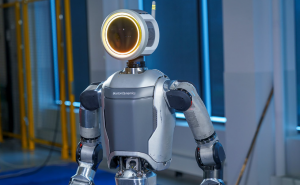Graphene to Shape the Future of IBM Computers
![]() Graphene, the world’s slenderest and toughest material, could help shape the next generation of computers replacing silicon, widely used in today’s digital electronics chips. Graphene, a single layer of carbon atoms, permits flow of electrons at much higher speeds than they do in silicon and it’s amazing flexibility would help scientists design smartphones and computers.
Graphene, the world’s slenderest and toughest material, could help shape the next generation of computers replacing silicon, widely used in today’s digital electronics chips. Graphene, a single layer of carbon atoms, permits flow of electrons at much higher speeds than they do in silicon and it’s amazing flexibility would help scientists design smartphones and computers.
IBM along with U.S. Department of Defense Advanced Research Projects Agency (DARPA), are working together on Graphene capabilities to create more advanced mobile phones, computers, wireless signals and radar systems.
Andre Geim and Konstantin Novoselov, the two scientists, both professors at the University of Manchester, made history when they discovered the potential of graphene which conducts electricity 30 times faster than silicon. The discovery led them to win the Nobel Prize for Physics last year. IBM researchers are now working on this technology to create much faster computers.
“They’ve observed a phenomenon that was unattainable previously,” said Yu-Ming Lin, an IBM researcher who had developed the first integrated circuit from wafer-size graphene in June. The research was co-funded by IBM along with Samsung and the U.S. Air Force and Navy. “The finding is bringing people’s attention back to graphene, and spurring a new look at whether the material is usable in digital widgets,” Lin said.
A number of companies are now working on this material and its future usage. Nokia is currently researching as how to use it in cell phones, touch screen devices, and printed electronics.
“Graphene as a cheap replacement for current touch screen technology is right around the corner,” said Jani Kivioja, Nokia’s researcher leader for graphene electronic sensing ability program. “This replacement is really low-hanging fruit, it can happen really soon. In the longer run, it might be possible that graphene could replace silicon,” said Kivioja.
Samsung, the consumer electronic leader, is another company who has invested in graphene research and development. Samsung predicts that graphene based products will be available in mainstream market in another five years.
IBM has also been investing a great deal in artificial intelligence and supercomputers. Its supercomputer projects Blue Brain and Blue Gene are helping scientists to create a virtual brain, one that’s in fact a computer, but still functions like a human brain. DARPA also invested $21 million for the production of a computer chip that functions much like the human brain. IBM plans to use the neurosynaptic chip with 10 billion neurons and 100 trillion synapses.
IBM’s intentions are good. They are thinking ahead and plan to produce a computer that will not only learn but can adapt what it learns to match new situations. Machines that would be working for humans and like humans are no longer a distant dream.
A message from John Furrier, co-founder of SiliconANGLE:
Your vote of support is important to us and it helps us keep the content FREE.
One click below supports our mission to provide free, deep, and relevant content.
Join our community on YouTube
Join the community that includes more than 15,000 #CubeAlumni experts, including Amazon.com CEO Andy Jassy, Dell Technologies founder and CEO Michael Dell, Intel CEO Pat Gelsinger, and many more luminaries and experts.
THANK YOU













